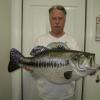With proper casting brake set-up, you should only need thumb to release and stop the spool (adjust final distance) - that's kinda the point, for brakes to take the place of your thumb modulating start and mid-cast.
But there's more to a proper cast, which is how you load the rod.
The bad habit brought from spinning tackle is wrist snap, which is rewarded in a spinning cast with extra distance. In a bait cast, this added jerk has to be subtracted by brake force to eliminate start-up backlash, so it adds Zero to a bait cast. If you only have linear mag brake (fixed-inductor BFS spool), wrist snap is start-up backlash (in a fly cast, wrist snap is a tailing loop). Maximum cast distance comes from smooth acceleration and wrist follow-through without adding jerk.
In the early 80s, I was fishing Ambassadeur weightless, and could out-distance guides with their weightless spinning tackle. I made a forward-spiral centrifugal cast, which is completely without jerk, and also effectively lengthens the rod (tricky thumb, feeding line during cast stroke). I PO'd two guides who tutored me on what was wrong with my cast, then we compared, and I doubled their cast distance. It's ok, I made them both look good back at the dock.
@FrnkNsteen those two anodize colors in my spool photos above are the stock inductors for all Z and SV brakes. Daiwa tunes those inductors on individual spools by shimming the inductor depth in the mag field (see white washer in SV photo above), and changing return-spring rates.
Also Note with Daiwa brake - leave the spool tension out of it.
Only adjust mag brake scalar to prevent mid-cast backlash throwing the lightest thing you plan to throw. If you're facing the wind, add 2 mag notches.
Thumb - if you want to become a thumb master, take one of these to the back acre.
Meek and Talbot NLW reels from the ninteen-teens held all world distance-casting records until Ambassadeur CT arrived in the '70s.




.thumb.jpg.df52404fc648bc17a641a50eb4c9dac9.jpg)